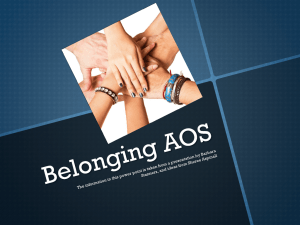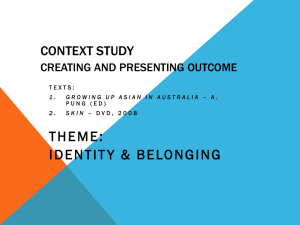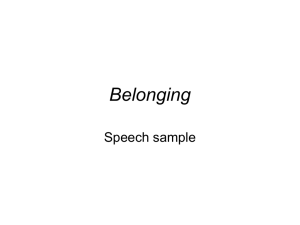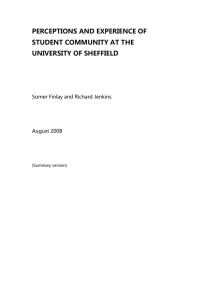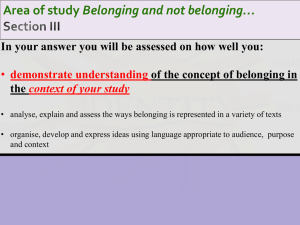Area of Study Paper 1 * Section II
advertisement
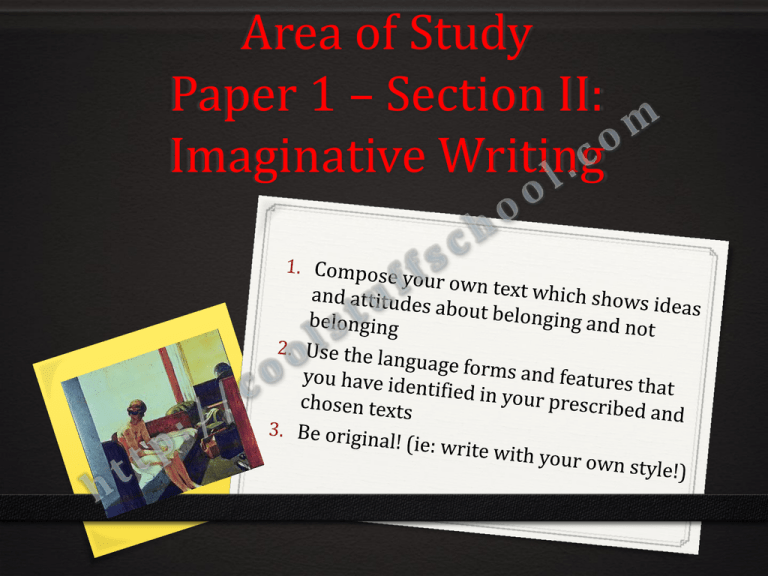
Area of Study Paper 1 – Section II: Imaginative Writing Examination Rubric… Section II 15 marks Attempt Question 2 Allow about 40 minutes for this section Answer the question in a SEPARATE writing booklet. Extra writing booklets are available. In your answer you will be assessed on how well you: ______________________________________________________________________________ express understanding of belonging in the context of your studies organise, develop and express ideas using language appropriate to audience, purpose and context _____________________________________________________________________________ • express understanding of belonging in the context of your studies 0 Show clear understanding of : 1. ideas, 2. attitudes, 3. beliefs about belonging and not belonging, by “representing” 1. Social ideas, attitudes and beliefs 2. Cultural ideas attitudes and beliefs 3. Historical / location ideas attitudes and beliefs of individuals – groups – communities – places and events “representing” Social ideas, attitudes and beliefs Cultural ideas attitudes and beliefs Historical / location ideas attitudes and beliefs of individuals – groups – communities – places and events 0 DON’T describe ideas about belonging 0 DON’T write a recount about “belonging” and “not belonging” 0 DON’T use essay-style analytical language / words (which you would use in Paper 1 Section III) 0 DO “show” the ideas about belonging (dialogue / language style / 0 0 0 0 metaphors / similes / personification… ) DO “show” the character’s and their respective attitudes to belonging DO write in the text type set by the exam. DO USE LANGUAGE – STRUCTURES – FORMS which achieve the purpose set by the exam DO USE LANGUAGE – STRUCTURES – FORMS which will work for the audience set by the exam Notes from the Board of Studies marking centre 2010 Section II Question 2 Candidates presented responses in a variety of forms, though narrative was the dominant choice. In better responses: 0 candidates used language appropriate to their chosen form of imaginative writing. 0 They explored the challenges of belonging and not belonging with insight, complexity and/or subtlety. 0 These responses displayed originality and artistry and the mechanics of language were applied skilfully. In sound responses, candidates tended to be more literal in their use of one of the quotations. They tended to be predictable, linear or clichéd in their examination of the challenges of belonging and not belonging. In these responses, the mechanics of language was controlled and writing structure was appropriate to form. Weaker responses tended to lack structural direction, were simplistic and inconsistent in their exploration of the challenges of belonging and not belonging. These responses lacked credibility, with limited appropriateness to audience and/or purpose. Flawed mechanics of language were usually a feature of these responses. Paper 1 Section II – 2010 exam Question 2 (15 marks) Select ONE of the quotations as the opening for a piece of imaginative writing that explores the challenges of belonging and not belonging. ‘I am outside the door.’ OR ‘We want to believe this is how it was . . .’ OR ‘I felt expelled and exiled . . .’ Paper 1 Section II – 2009 exam Question 2 (15 marks) “Human beings, like plants, grow in the soil of acceptance, not in the atmosphere of rejection.” “When someone prizes us just as we are, he or she confirms our existence.” Drawing on the ideas in ONE of these quotations, write an imaginative piece that celebrates the ways relationships contribute to a sense of belonging. write an imaginative piece… 0 An imaginative piece can be in your choice of: 0 Feature article 0 Script 0 Newspaper article 0 Short story 0 Journal entry(s) 0 Diary 0 Narrative 0 Motivational Speech Choose the texttype that you know best… (if you are given a choice…) 0 If you’re best at formal and factual writing – try a feature article or a newspaper article 0 If you’re best at short stories and narratives – make sure you develop character and attitudes in a way that grabs (and holds) the readers’ attention 0 If you prefer informal, conversational writing – try a blog… a journal… a diary… an email “conversation”… etc. 0 Whichever text-type you choose – focus on developing and maintaining the “tone” of voice which is most suitable for that particular text-type. Short story? 0 Have a clear theme. What is the story about? That doesn't mean what is the plot line? It means… what is the underlying message or statement behind the words. Get this right and your story will have more importance in the minds of your readers. 0 A good short story covers a very short time span. It may be one single event that becomes a “life-changing” moment in the life of the character 0 Don't have too many characters. Have only enough characters to show the theme. Two contrasting characters will do the trick. 0 Make every word count. There is no room for wordy explanations in a short story. If each word is not working towards putting across the theme, delete it. 0 Focus… on developing your theme – your main character – and resolving a conflict / issue / problem Show vivid imagery in short stories… 0 Use specific, concrete details / names: An example from Upon a Mystic Tide: “Sitting in her old, red rocker, Miss Hattie turned on the large, antique radio behind her. Big band era music drifted through the kitchen, and she softly hummed along with it. Her head bowed, she studied the embroidery in her lap. She was sewing the Seascape Inn logo onto a new batch of crisp, white napkins.” In this example, the specific and concrete details are: the red rocker, the large, antique radio, embroidering napkins, the big band music and humming. 0 More specific and concrete details… 0 Don't write tree. Write oak. 0 Don't write emotion. Write fear or sorrow, guilt or shame. 0 Don't write dog. Write Doberman, or Yorkie. 0 Don't write chair. Write rocker. 0 Write cinematically. Write vivid images that create pictures in the reader's mind just like the scenes you see in a film Stay tuned… 0 More tips in the next chapter of… Area of Study Paper 1 – Section II: Imaginative Writing

